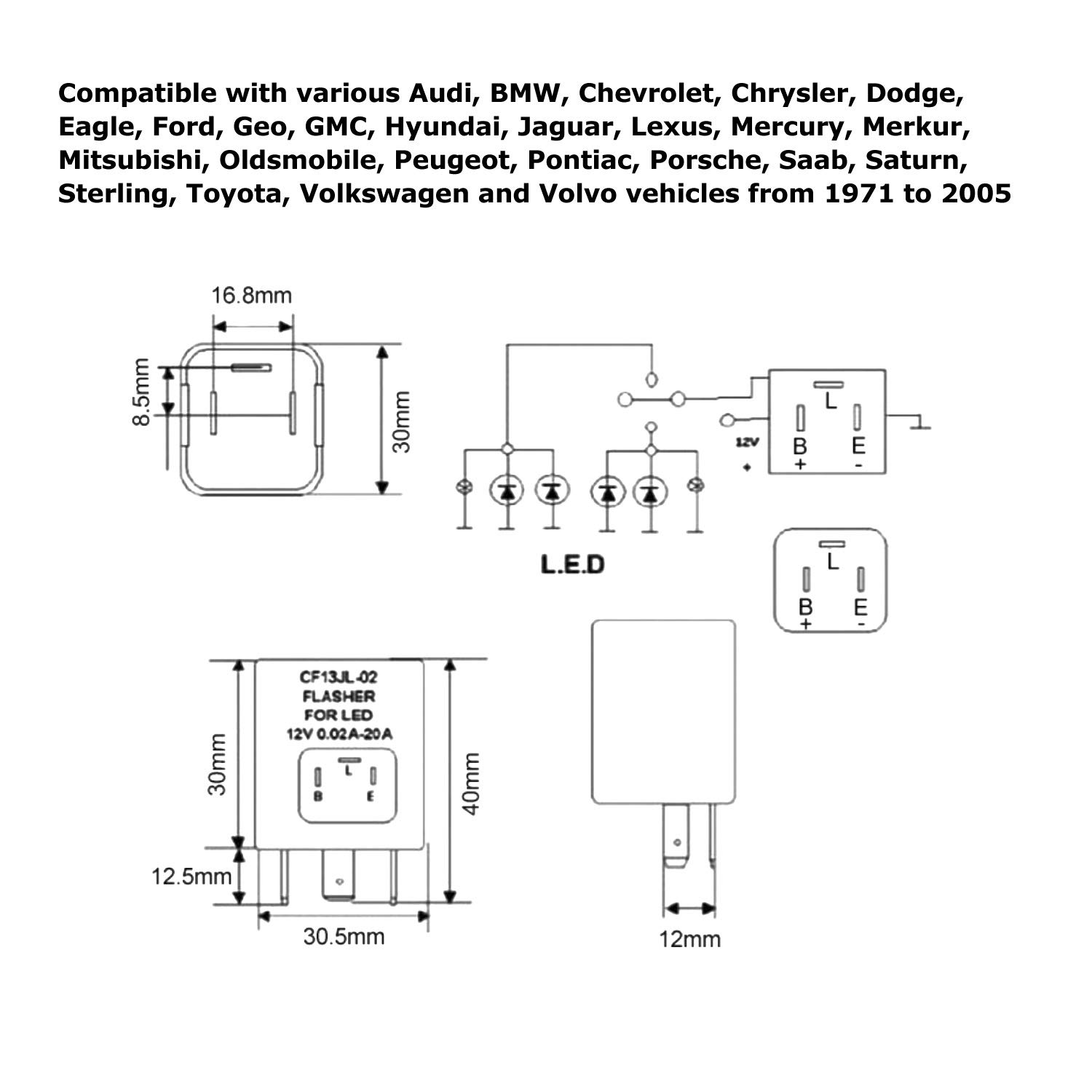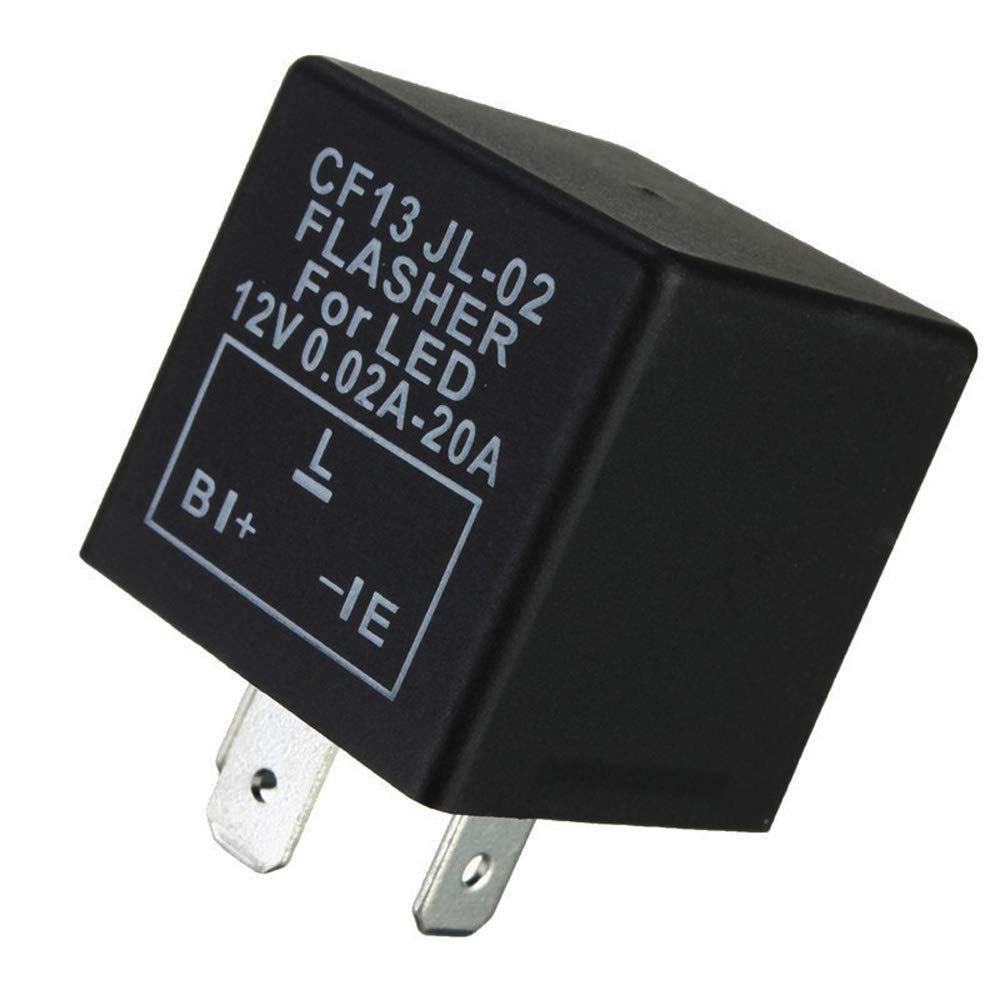Descrição do Produto: iJDMTOY 3-Pin CF-13 CF13 EP34 Electronic Flasher Relay
O iJDMTOY 3-Pin CF-13 CF13 EP34 é um relé eletrônico de pisca-pisca projetado para resolver o problema de flash rápido em veículos que utilizam lâmpadas LED. Compatível com uma ampla gama de veículos fabricados entre 1971 e 2005, este relé é a solução ideal para quem deseja atualizar a iluminação do seu carro sem complicações. Antes de realizar a compra, é essencial verificar as imagens da galeria e a descrição do produto para garantir a compatibilidade com o seu veículo, ou consultar o relé original do seu carro.
Este módulo de relé possui um corpo de plástico resistente e contatos niquelados, medindo 1.2×1.2×1.2 polegadas. A instalação é simples e direta: basta desconectar o relé original, que geralmente está localizado sob o painel ou na caixa de fusíveis do motor, e substituí-lo pelo relé eletrônico LED da iJDMTOY. Este relé elimina a necessidade de modificações complexas, como emenda de fios ou adição de resistores de carga, garantindo uma taxa de flash normal para lâmpadas de sinalização LED, tanto na frente quanto na traseira do veículo.
Características do Produto:
– Compatibilidade: Projetado para veículos de 1971 a 2005. Verifique a compatibilidade com o relé original.
– Construção: Corpo em plástico com contatos niquelados, garantindo durabilidade e resistência à corrosão.
– Dimensões: 1.2×1.2×1.2 polegadas, ideal para instalação em espaços reduzidos.
– Solução Eficiente: Resolve o problema de flash rápido de forma eficaz, sem necessidade de modificações adicionais.
– Instalação Simples: Substituição direta do relé original, sem necessidade de ferramentas especiais.
- Instruções de Uso:
Para utilizar o relé eletrônico iJDMTOY, siga os passos abaixo:
1. Localize o relé de pisca-pisca original do seu veículo, que geralmente está localizado sob o painel ou na caixa de fusíveis do motor.
2. Desconecte o relé original com cuidado.
3. Compare o novo relé com o original, verificando o número de pinos e a configuração.
4. Conecte o relé eletrônico iJDMTOY no lugar do relé original, garantindo que esteja bem encaixado.
5. Teste as luzes de sinalização para confirmar que o problema de flash rápido foi resolvido.
Perguntas Frequentes (FAQ):
Pergunta: Este relé é compatível com todos os veículos?
Resposta: Não, o relé iJDMTOY é compatível com veículos fabricados entre 1971 e 2005. É importante verificar a compatibilidade antes da compra.
Pergunta: Posso usar este relé com lâmpadas halógenas?
Resposta: Este relé é projetado especificamente para lâmpadas LED. O uso com lâmpadas halógenas pode não proporcionar o desempenho desejado.
Pergunta: O que fazer se o relé não funcionar após a instalação?
Resposta: Verifique se o relé foi instalado corretamente e se é compatível com o seu veículo. Se o problema persistir, entre em contato com o suporte ao cliente.
Pergunta: Preciso de ferramentas especiais para a instalação?
Resposta: Não, a instalação é simples e não requer ferramentas especiais. Basta desconectar o relé original e conectar o novo.
Pergunta: Este relé pode causar superaquecimento?
Resposta: Não, o relé iJDMTOY é um modelo sem aquecimento, projetado para funcionar de forma eficiente sem risco de superaquecimento.
 Frete Grátis em todos os produtos
Frete Grátis em todos os produtos












![Adaptador Veicular SUPERONE 180W com 2 Soquetes e Carregador USB C PD 20W - Divisor de Isqueiro para GPS e Dash Cam - [Atualização 2025]](https://m.media-amazon.com/images/I/61oiVlv1qvL._SL1500_.jpg)



Jeff in Texas –
This was a quick and easy fix to hyper flashing caused by switching from incandescent bulbs to LED (1157A).
Removed 2 screws and popped off the panel directly under the steering column. The OEM flasher is mounted to a special retention bracket. I disconnected the cable, plugged the cable into this replacement flasher and then secured the new relay to a harness by using a zip-tie. Put the panel back & replaced the screws.
10-15 minutes tops. Works as expected and hyper flash condition is back to normal.
Tesla_Store –
Replaced my stock 2001 Subaru Forester Blinker Relay with this one. My blinkers & hazard lights stopped working. No clicking, no anything. I tried to replace the hazard button but no fix. I then replaced the relay with this one and it worked. I am still using stock blinker bulbs but hope to upgrade to LED in the near future. The previous comments say the blinker is quiet, that is true. Works great besides that. Plug-N-Play. Thank you.
Rektakular –
After doing some research I read that this flasher relay would fit in my 1999 Integra, but that turned out to not be the case. The pins were spaced and sized correctly but the outer casing was just barely too big to fit. To remedy this, I popped off the outer casing and used a dremel to grind down the plastic edge that stuck out too far. It works exactly as it should and fixed the hyperflash caused by my LED turn signals, it just doesn’t have an outer casing now.
As far as I know, most older Honda’s use the same flasher relay, so just know that it takes modification to make it fit. If that’s not okay with you, don’t buy this.
If you’re considering a flasher relay or load resistors, go with the flasher relay. Load resistors increase current draw and usually require you to hack up your wire harness.
Ken –
Upgraded my Samurai to LED lights and had the usual flickering issues, this flasher solved the problem perfectly. It is a little larger than the flasher it replaced but there was plenty of room for it to fit in without doing any modifications.
D. Poynter –
Used this in a 2003 Ford Econoline e350 van. The original turn signal/blinker/flasher had Ford written on it with the model TBB89 stamped on it plus the label PA6-GF30 … replaced with the 3-Pin CF-13 and it worked great. I had previously used the load resisters on my back break lights, which are LEDs. The turn signal lights would hyper flash ONLY when the headlights were on. Load resisters would work to remove hyper flash mostly but would continue to hyper flash when the headlights were on.. This blinker solved all my troubles. Took out all the load resisters and now the van just simply works without hyper flash at a good speed. Great product.
medicbiker –
I ordered two for my enduro and vintage yamaha. I am running 1156 LED bulbs in my signals. Would not flash at all, just stays on steady. On the enduro all turn signals lit up, regardless of whether I put the turn signal on left or right. I bought a relay from Lockhart Phillips and it worked fine on both bikes.
Todd S Yingst –
It works, as designed… Works, works, works, WTF what do they expect here? 7 more words… works works works works.
M –
Fixed hyperflash. Depending on the vehicle, the location of the signal relay could either be easy access or just have enough wiggle room without removing too many panels. Mine was the latter. Easy install (except for the location in my car), worked as advertised and fixed the flash rate to normal.
A couple of things to keep in mind. This is a universal fit for multiple applications, it will work for your car but can not be clipped in place like the OEM relay. So you have to tape it somehow to the wiring harness so that it doesn’t pop out. Then you have to tape or use command strip to stick this onto the side of sturdy metal fixed piece as to not bounce around while driving. This could be easy or challenging depending on location in car. Mine is under the steering column just below the instrument panel and center dash.
The one thing (like previously stated in other comments) i noticed that will bother me but i will have to live with is the delay with the clicks. After you stopped your turn signal, it continues the clicking sound for a couple more instances, and when you enable your turn signal, it has a one to two click delay.
Mike K –
Worked as I expected! Many people doing LED lighting upgrades to their cars and trucks end up splicing in a load resistor to fool the factory blinker relay into thinking there is a normal incandescent bulb in there. You don’t have to do no splicing into the electrical wiring in the car, you simply install a Electronic flasher in place of the normal one. Bit if info for you on the concept of the flasher relay: Original relays use a bi-metallic relay contact inside that when a load (the light bulb) is on it causes the metal to heat up and in doing so it flexes causing the relay to either open or close depending on the type. When you install a LED bulb the power it requires is 1/8th of that of a incandescent bulb so the relay opens and closes very fast (I.E. the fast flashing turn signal). With a electronic flasher relay the time it takes to open/close the relay is controlled by a timer chip that is set at a specific time no matter what the load is on it, so hence the LED bulb will flash at a steady rate. Lastly those load resistors you buy and splice into the electrical wire basicly makes the relay see a normal load and it works, downside it that a LED bulb uses 1/8th the power then a normal bulb (this is a good thing) but by using that load resistor your then making the adding the low power LED + the resistor and your right back up to using the same about if not more power than you were using with the incandescent bulb. In short this is the best way to correct the fast blinking when upgrading to LED turn signals!
Canadian Car Guy –
Okay, here’s the thing: This relay is supposed to fit most Japanese vehicles for installing LED bulbs in your turn signals to eliminate hyper flashing. It works fine, but in my car, (an 2002 EP3 Civic Hatchback) it wouldn’t physically fit in the fusebox. I was able to make it work anyway, by removing the cubic black plastic housing, and trimming the flat piece around the prongs with wire cutters to make it go in. Since the fusebox is under the dash, I’m not worried about getting water or anything on the circuit board, and it works great now with my LED turn signals. I’ll try to get measurements of the housing to let you folks know how much space you need to make this work without modification.
From a functional standpoint, it does exactly what it’s supposed to do, and is very inexpensive. I can’t blame the seller for the issue with my particular vehicle, as this is a semi-universal part. That means five stars!